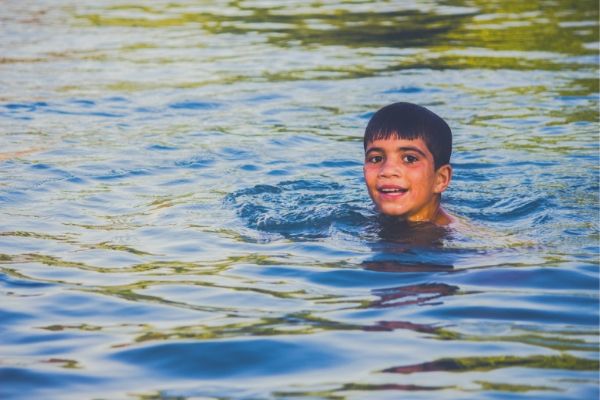At The Swim Revolution, we model our FUNdamentals teaching curriculum off of 3 main things:
- The skills children actually use while play swimming
- The skills children need to learn in order to pass a swim test and swim-safer
- Studying how children learn best
Treading water is often a skill that is taught in more advanced swimming lesson levels and that’s where we used to teach it too. Recently we structured our curriculum to start teaching treading water in our FUNdamentals level. Why? For 2 reasons: 1) when we observed and studied what skills kids were using (or trying to use) while play-swimming, treading water came up and 2) when we looked at what skills were required of children at most pools to pass the swim test, treading water came up.
It really is a safer-swimming skill. Simply put, a child who can tread water is safer than a child who cannot. Whether your family swims mostly in pools or open water, it is vitally important that children learn to tread water.
What is treading water?
Think, “running in place,” but while swimming in the pool. When you successfully tread water, your body is generally upright. You move your hands, arms, feet, and legs in a way that allows your head to stay above the water. Ideally, this should not take a huge amount of energy, although you do have to build stamina if you want to be able to tread water for a long period of time.
The main goal of treading water is to keep your head above the water without becoming exhausted. Because it uses less energy than swimming, it is a great way to avoid fatigue in both play and emergency situations.
Kids need to learn this because it keeps them from sinking when they don’t have flotation available, or if they need to wait for assistance from an adult. Treading water is not about propulsion or getting from Point A to Point B in the pool. Rather, it’s about getting a breathe and looking for the nearest pool exit, asking for help, catching a ball or calling out to your friend during play.
How do you teach this skill to a child?
Most children don’t naturally tread water. Even a child who takes to the pool with ease may struggle to keep their head above water while staying in one place. That makes it especially important to be intentional in teaching your child to tread water. We recommend starting to practice this in the shallow end.
The easiest way to help your child develop the coordination and muscle movement patterns necessary to tread water is to do what we’ve been doing for all other swimming skills up to this point - start with a progressive training vest. Once your child has the basics down, we can start slowly removing floatation until he or she is treading water completely on his or her own.
Here’s how we do it:
“Running in place” in the water
Remember to stay outcome focused and worry less about the minute details. Your first real goal here is to get your child able to stay in one spot while kicking and paddle swimming vertically. As with all other skills we’ve learned up to this point, we can make this complex or simple.
- Start your child out in the pool a comfortable distance away from the wall or steps
- Have your child start swimming in place
- You can come behind your child and guide his or her hands back and forth, almost like a clapping motion in the water.
- Hands come close together in the front of the body and then turn to face out and push the water out to the sides just past shoulder width - this is called sculling
- Your child’s hands should be shaped just like they were from the paddle swimming exercise in Lesson #4
- The kicking should stay vertical and can be the standard flutter-kick your child has been using for front kick - or more like the pedaling motion used to ride a bike (recommended)
Coordination will take time, the ultimate goal is swimming while staying put in the water
The next stage is to bring these two skills together. Being able to flutter kick or bicycle kick while also sculling the hands is the key to treading water! Practice with floatation and hands-on support.
Increase the duration of time your child treads water
Treading water is pretty tough for a young beginner swimmer. Even with the vest on, starting treading water for 10-20 seconds is a good amount of time. Ultimately, you’ll want to slowly work your way up to treading water for 2 minutes - this is the standard most pools use for passing a child through a swim test.
As your child builds coordination and can perform the treading water exercise for longer durations of time with full floatation in their progressive training vest, remove 1-2 floatation inserts at a time and try again. It might take several lessons and attempts at treading water at the new floatation level before your child is strong enough and comfortable enough to remove more. Always stay where your child is comfortable and never remove more flotation than your child is ready for. If your child’s head is too low in the water and he or she is struggling to catch a breath, you’ve removed too much for today’s lesson and you should add another float back into the vest.
Continuing our theme of safety skills...
In our next post, we will be talking about the key safety skills you can teach your child to ensure that they are safe in the water! There are things that you can do now, even if your child is really young, to promote water and swimming safety. Don’t forget to sign up for email reminders of the posts in the rest of this series so that you don’t miss a single set of instructions!
And don’t forget to check out our FUNdamentals class for kids ages 2.5 through 8 years old. This course covers many of the skills we have been discussing in this series of posts. Here in Atlanta, we offer highly effective swimming lessons with a great teacher to student ratio. Give us a call at (404) 354-1180 to sign up today or schedule a free class to learn more.





